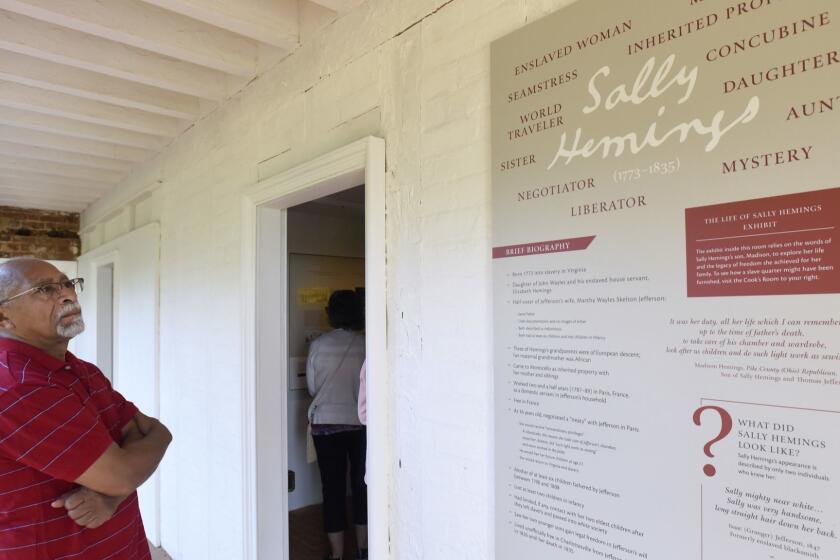Op-Ed: What would you pay for Melania’s big white hat?

- Share via
Former First Lady Melania Trump is holding a hat auction. Or rather, she is auctioning off a single white hat and two pictures of herself wearing it. Together, the lot is called the “Head of State Collection.” Bidding starts at $250,000 and runs through Jan. 25.
Trump wore the “iconic, white broad-brimmed, high blocked crown hat” (as her website describes it) in April 2018, to welcome French president Emmanuel Macron and his wife to the White House. French American designer Hervé Pierre, who often styled the first lady, created the hat in white crepe to match the all-white Michael Kors suit she wore that day. The rest of the auction lot consists of a watercolor of Trump in the hat (just her head, in profile) and an NFT — a non-fungible token — of the watercolor, both by French fashion illustrator Marc-Antoine Coulon.
“Head of State Collection” is a puzzling title since nothing in the lot pertains directly to a head of state — “first lady” denotes an unofficial role in American governance.
A few interpretations come to mind: First, because Donald Trump was the U.S. head of state, perhaps the assumption is that the title can extend to his family too, enhaloing Melania et al., something akin to the royal family. “Head of State” could also function as a Trump lifestyle brand. Remember: Even during his presidency, Donald sold Trump-branded merch — cufflinks, perfume, stuffed animals, sports gear — on a Trump Store website.
Nonfungible tokens are a dressed-up species of bookkeeping. But what art needs is less auditing and more ecstasy.
Or maybe “Head of State” refers solely to Macron, the first foreign head of state to be entertained officially by President Trump, occasioning the wearing of the white hat. In this case, the auction’s allure would derive from its proximity to France and French things — which makes some sense since it showcases the work of two French artists — Pierre and Coulon.
And of course, “Head of State” could refer to that big white hat itself — something worn on the head, thus literalizing the metaphor. That the artworks depict only Trump’s head lends weight to this possibility. This interpretation is also in keeping with Coulon’s earlier NFT artwork, “Melania’s Vision,” which was released for sale in late December. It included an audio component: Trump defining her vision as looking forward with inspiration — but the artwork fulfilled its title only in the most literal, even ophthalmological sense: It depicted Trump’s actual eyes (fully made up, under arched brows).
It’s starting to seem as though Trump is fragmenting and selling off disconnected parts of her body — head, eyes — in a strangely self-fetishizing way.
A first lady’s garments and accessories can and do hold real value. (Taxpayers don’t pay for them; some are gifts that become the property of United States, the rest are paid for and belong to the first lady.) But their value is historical rather than strictly monetary. Articles of presidential fashion can powerfully conjure not only their wearers but vast underlying swaths of culture and history as well. This is why they end up in museum exhibitions and archives.
No one thought the rollout of Melania Trump’s “Be Best” campaign against cyberbullying was going to go perfectly.
It’s thrilling, for example, to see the Michelle Smith gown former First Lady Michelle Obama wore for her official portrait by Amy Sherald. Thrilling to recall that subject and painter were Black, a historic first, and that the dress’s geometric pattern evoked Gee’s Bend quilts created by Black women in Alabama. It’s equally thrilling to view Mary Todd Lincoln’s silk capelet, created in 1861 by Elizabeth Keckley — a woman who bought herself out of slavery and rose to become a renowned dressmaker to powerful women. (Both garments were recently shown in a first lady exhibition at the National Portrait Gallery.)
Those items deserve the term “iconic,” no question. But “iconic” doesn’t really apply to the white hat, which evokes no specific historic contribution, or even a strong sense of Melania Trump’s physical presence or signature style. (She was not particularly known for wearing enormous hats.)
This hat, in particular, conveys the opposite of a specific presence and identity. With its enormous face-shielding brim, it telegraphs anonymity and a desire to hide. What’s more, in photographs from the Macron visit, the brim creates a kind of no-fly perimeter around the first lady’s whole body — the millinery equivalent of a “No Trespassing” sign. (At the time, some interpreted the look as a tacit retort to the Stormy Daniels allegations about her husband that had recently come to light.)
All three of the January auction items bear Melania Trump’s signature, perhaps in an attempt to add a personal touch to their blankness and anonymity (exacerbated by the expressionless gaze Trump wears in Coulon’s sketch.)
It is now widely understood that my ancestor Sally Hemings, an enslaved black woman, was the intimate companion of Thomas Jefferson for nearly four decades.
It’s not unusual for celebrity-auction memorabilia to be signed, but generally there is an organic connection between the signer and the object signed. A rock star might sign his guitar. Sports heroes might sign a baseball bat or a football helmet. Those signatures indicate something beyond possession, but the same can’t be said of Melania Trump’s signature on Pierre’s hat. It may raise the sale price, though. (According to the auction announcement, “a portion of the proceeds” will be donated to foster children causes, but reporters have been unable to get an answer as to the details.)
Finally, we shouldn’t ignore that a century of pop culture has taught us to associate white hats with the Lone Ranger, John Wayne and the cavalry riding to the rescue — the good guys. And we can’t ignore that Trump announced her hat sale on the eve of the anniversary of the Jan. 6 insurrection.
Perhaps this law-and-order symbolism was the point all along: Even more than money, what the Trumps may need now is to deflect any blame for that day’s violence, and to refashion themselves as cinematic saviors in a shootout, virtuous cowboys (and cowgirls) of days gone by.
And what better prop for the job than a high, wide — and very expensive — big white hat?
Rhonda Garelick is dean of the school of art and design history and theory at the Parsons School of Design in New York.
More to Read
A cure for the common opinion
Get thought-provoking perspectives with our weekly newsletter.
You may occasionally receive promotional content from the Los Angeles Times.











